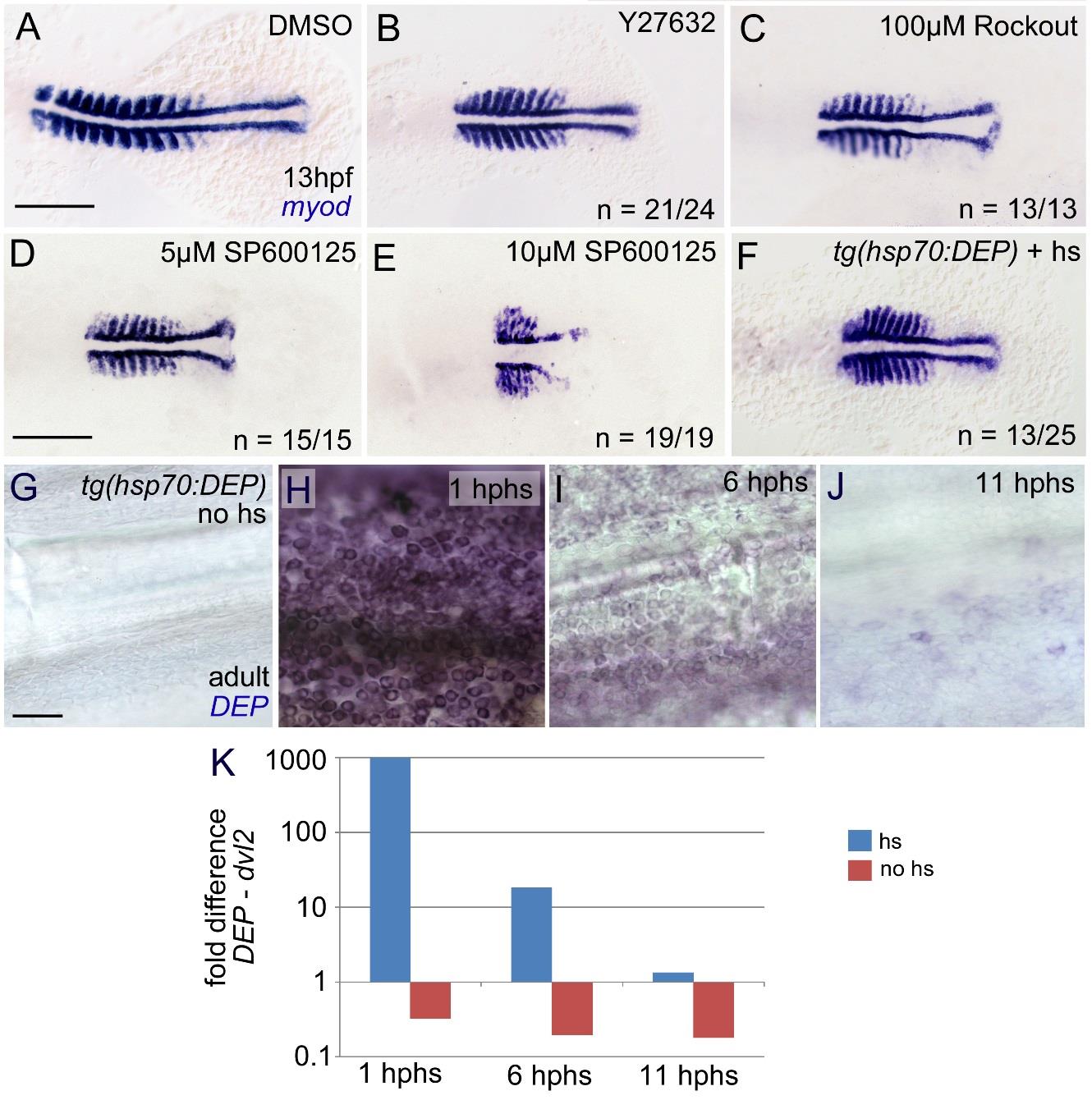Fig. S7
The Rock inhibitors Y27632 and Rockout and the JNK inhibitor SP600125 cause compromised convergent extension similar to the effects of transgenic inhibition of the PCP pathway.(A-F) Whole mount myoD in situ hybridization of presumptive paraxial muscle cells at 13 hpf (10-somite stage); dorsal views on flat-mounts; anterior to the left. Embryos shown in (A,C-E) had been incubated in medium containing the indicated drugs at the indicated concentration, starting at 4 hpf; embryo shown in (B) had been microinjected with Y-27632 at the 1-cell stage (2 nl of 400 µM solution), as described (Lai et al., 2005; Lou et al., 2012). Therefore, no final Y-27632 concentration is supplied in the panel. However, assuming that the cytoplasm of freshly laid eggs has a volume of 0.6 mm3 (1/3 of the total volume of the egg), it should be approximately 1 µM). Embryo shown in (F) derives from a cross of Tg(hsp70l:DEP) transgenic and a wild-type parent, and was subjected to a 40°C heat shock from 4 to 4.5 hpf. Only approximately 50% of the offspring were affected, corresponding to the expected ratio of transgene segregation. Compared to the control (A), embryos shown in (B-F) display a shorter and broader body axis, similar to mutants in PCP pathway components (Marlow et al., 2002; and references therein). (G-J) Xenopus Dishevelled DEP in situ hybridization of amputated tail fins from Tg(hsp70l:DEP) adults without heat shock (G) and at 1 hour, 6 hours and 11 hours after heat shock application (hphs). Transcripts encoding the DEP domain of Xenopus Dishevelled are readily detectable at 1 (H) and, at significantly lower levels, at 6 (I) and 11 hphs (J). This points to efficient transgene expression, but limited stability of the transgene-encoded transcripts. (K) Xenopus Dishevelled DEP qRT-PCR analysis of RNA extracted from the skin of the wounded flank of heat-shocked (blue) or, as control, non-heat-shocked (red) Tg(hsp70l:DEP) adults with a 7500 Fast Real Time PCR System (Applied Biosystems, Waltham, MA) and SYBR green for DNA quantification. Obtained values were normalized against gapdh and compared to endogenous dvl2 at three different time points after heatshock application and full-thickness wounding: 1 hour after heat shock (hphs), 0 hpw: 987-fold higher; 6 hphs, 5 hpw: 18-fold higher; 11 hphs, 10 hpw: 1.3-fold higher expression levels of transgenic dsh-DEP compared to endogenous dvl2. Sequences of primers used were: Xenopus dsh-DEP forward: TTGTGAAGGTCATGGCTTCC, reverse: ATAGAGCCAGTCCACCACAT; zebrafish dvl2 forward: GCCTCCTCTTTCAGCAGTGT, reverse: CCCACGATACTGATGCCCAA; gapdh forward: CGCTGGCATCTCCCTCAA, reverse: TCAGCAACACGATGGCTGTAG. Similar results were obtained in three independent experiments. For wound closure analyses, transgenic fish were either heat-shocked once (1 hour before wounding; see Materials & Methods) or twice (1 hour before and 5 hours after wounding), yielding indistinguishable results (insignificantly reduced closure rates; Fig. 4B and data not shown). This suggests that a single heatshock application is sufficient to block PCP signaling, and provides further evidence that PCP signaling is largely dispensable for wound closure. Scale bars: A-F: 200 µm; G,H: 50 µm.

